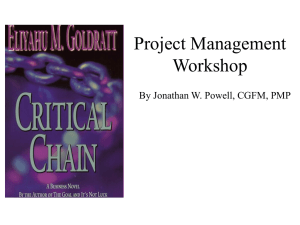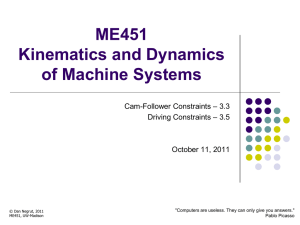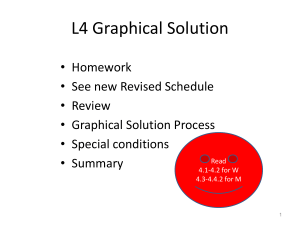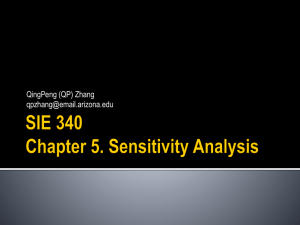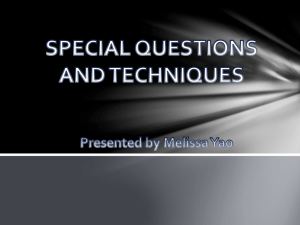ppt - SBEL
advertisement
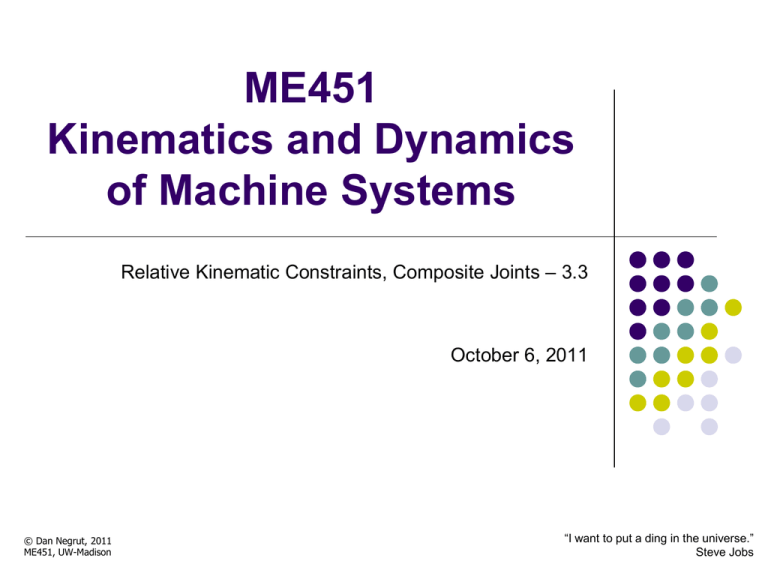
ME451 Kinematics and Dynamics of Machine Systems Relative Kinematic Constraints, Composite Joints – 3.3 October 6, 2011 © Dan Negrut, 2011 ME451, UW-Madison “I want to put a ding in the universe.” Steve Jobs Before we get started… Last Time Discussed relative constraints x, y, relative constraints distance constraint For each kinematic constraint, recall the procedure that provides what it takes to carry out Kinematics Analysis Today Covering relative constraints: Identify and analyze the physical joint Derive the constraint equations associated with the joint Compute constraint Jacobian q Get (RHS of velocity equation) Get (RHS of acceleration equation, this is challenging in some cases) Revolute, translational, composite joints, cam-follower type constraints Skipping gears Assignment, due in one week 3.3.2, 3.3.4, 3.3.5 + MATLAB + ADAMS 2 Revolute Joint Step 1: Physically imposes the condition that point P on body i and a point P on body j are coincident at all times Step 2: Constraint Equations (q,t) = ? Step 3: Constraint Jacobian q = ? Step 4: = ? Step 5: = ? 3 Translational Joint Step 1: Physically, it allows relative translation between two bodies along a common axis. No relative rotation is allowed. Step 2: Constraint Equations (q,t) = ? Step 3: Constraint Jacobian q = ? Step 4: = ? Step 5: = ? NOTE: recall notation 4 Attributes of a Constraint [it’ll be on the exam] What do you need to specify to completely define a certain type of constraint? In other words, what are the attributes of a constraint; i.e., the parameters that define it? For absolute-x constraint: you need to specify the body “i”, the point P that enters the discussion, and the value that xP should assume For absolute-y constraint: you need to specify the body “i”, the point P that enters the discussion, and the value that yP should assume For a distance constraint, you need to specify the “distance”, but also the location of point P in the LRF, the body “I” on which the LRF is attached to, as well as the point of coordinates c1 and c2 How about an absolute angle constraint? Think about it… 5 The Attributes of a Constraint [Cntd.] Attributes of a Constraint: That information that you are supposed to know by inspecting the mechanism It represents the parameters associated with the specific constraint that you are considering When you are dealing with a constraint, make sure you understand What the input is What the defining attributes of the constraint are What constitutes the output (the algebraic equation[s], Jacobian, , , etc.) 6 The Attributes of a Constraint [Cntd.] Examples of constraint attributes: For a revolute joint: You know where the joint is located, so therefore you know For a translational join: You know what the direction of relative translation is, so therefore you know For a distance constraint: You know the distance C4 7 Example 3.3.4 Consider the slider-crank below. Come up with the set of kinematic constraint equations to kinematically model this mechanism Use the Cartesian (absolute) generalized coordinates shown in the picture 8 Example 3.3.2 – Different ways of modeling the same mechanism for Kinematic Analysis Approach 1: bodies 1, 2, and 3 Approach 3: bodies 1 and 2 Approach 2: bodies 1 and 3 Approach 4: body 2 9 Page 68 (unbalanced parentheses, and text) Page 73 (transpose and sign) Errata: Page 67 (sign) Page 73 (perpendicular sign, both equations) 10 Composite Joints (CJ) Just a means to eliminate one intermediate body whose kinematics you are not interested in Revolute-Revolute CJ Also called a coupler Practically eliminates need of connecting rod Given to you (joint attributes): Revolute-Translational CJ Given to you (joint attributes): Distance c Point Pj (location of revolute joint) Axis of translation vi’ Location of points Pi and Pj Distance dij of the massless rod 11 Composite Joints One follows exactly the same steps as for any joint: Step 1: Physically, what type of motion does the joint allow? Step 2: Constraint Equations (q,t) = ? Step 3: Constraint Jacobian q = ? Step 4: = ? Step 5: = ? 12 We will skip Gears (section 3.4) 13 Gears Convex-convex gears Gear teeth on the periphery of the gears cause the pitch circles shown to roll relative to each other, without slip First Goal: find the angle , that is, the angle of the carrier What’s known: Angles i and j The radii Ri and Rj You need to express as a function of these four quantities plus the orientation angles i and j Kinematically: PiPj should always be perpendicular to the contact plane 14 Gears - Discussion of Figure 3.4.2 (Geometry of gear set) 15 Gears - Discussion of Figure 3.4.2 (Geometry of gear set) Note: there are a couple of mistakes in the book, see Errata slide before 16 Example: 3.4.1 Gear 1 is fixed to ground Given to you: 1 = 0 , 1 = /6, 2=7/6 , R1 = 1, R2 = 2 Find 2 as gear 2 falls to the position shown (carrier line P1P2 becomes vertical) 17 Gears (Convex-Concave) Convex-concave gears – we are not going to look into this class of gears The approach is the same, that is, expressing the angle that allows on to find the angle of the Next, a perpendicularity condition using u and PiPj is imposed (just like for convex-convex gears) 18 Example: 3.4.1 Gear 1 is fixed to ground Given to you: 1 = 0 , 1 = /6, 2=7/6 , R1 = 1, R2 = 2 Find 2 as gear 2 falls to the position shown (carrier line P1P2 becomes vertical) 19 Rack and Pinion Preamble Framework: Two points Pi and Qi on body i define the rack center line Radius of pitch circle for pinion is Rj There is no relative sliding between pitch circle and rack center line Qi and Qj are the points where the rack and pinion were in contact at time t=0 NOTE: A rack-and-pinion type kinematic constraint is a limit case of a pair of convex-convex gears Take the radius Ri to infinity, and the pitch line for gear i will become the rack center line 20 Rack and Pinion Kinematics Kinematic constraints that define the relative motion: At any time, the distance between the point Pj and the contact point D should stay constant (this is equal to the radius of the gear Rj) The length of the segment QiD and the length of the arc QjD should be equal (no slip condition) Rack-and-pinion removes two DOFs of the relative motion between these two bodies 21 Rack and Pinion Pair Step 1: Understand the physical element Step 2: Constraint Equations (q,t) = ? Step 3: Constraint Jacobian q = ? Step 4: = ? Step 5: = ? 22 End Gear Kinematics Begin Cam-Follower Kinematics 23 Preamble: Boundary of a Convex Body Assumption: the bodies we are dealing with are convex To any point on the boundary corresponds one value of the angle (this is like the yaw angle, see figure below) The distance from the reference point Q to any point P on the convex boundary is a function of : It all boils down to expressing two quantities as functions of The position of P, denoted by rP The tangent at point P, denoted by g 24 Cam-Follower Pair Assumption: no chattering takes place The basic idea: two bodies are in contact, and at the contact point the two bodies share: The contact point The tangent to the boundaries Recall that a point is located by the angle i on body i, and j on body j. Therefore, when dealing with a camfollower, in addition to the x,y, coordinates for each body one needs to rely on one additional generalized coordinate, namely the contact point angle : Body i: xi, yi, i, i Body j: xj, yj, j, j 25 Cam-Follower Constraint Step 1: Understand the physical element Step 2: Constraint Equations (q,t) = ? Step 3: Constraint Jacobian q = ? Step 4: = ? Step 5: = ? 26
